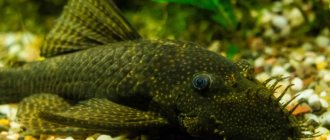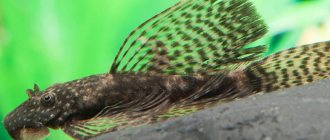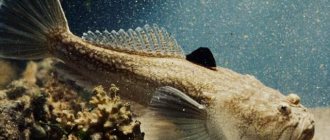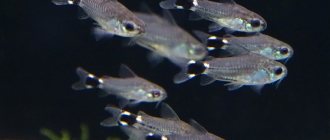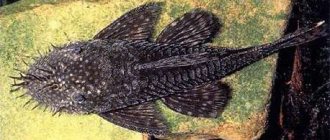Male and female Ancistrus... which one is which? This is the question asked by beginning aquarists who want to add these strange-looking catfish to their aquarium, having heard a lot of information from everywhere about their benefits and active participation in cleaning the aquarium.
It is also necessary to be able to distinguish the sex of these catfish if you are going to get offspring from them at home. We will consider this information in detail in our article.
Ancistrus - reproduction
To be sure to get offspring, these fish need to be placed in another aquarium. It will not be possible to get small fish if there are several male Ancistrus. In nature, spawning of ancistrus begins during the rainy season, but to ensure this in the aquarium, it is necessary to change the water very often and strengthen it with aeration. Fish eggs are laid in all kinds of shelters, so you need to put a broken vase, a flat brick, a plastic tube or special houses in the aquarium. The male Ancistrus cleans this shelter with his sucker, and the female is nearby all the time. When both fish are ready to spawn, the female climbs into the shelter and lays a cluster of eggs, and the male fertilizes them. Ancistrus caviar is small in size, its diameter is 2 or 3 millimeters, and its color is orange or bright yellow.
How to choose catfish
Catfish are very diverse both in nature and in the aquarium. But when buying a specific species, you need to have a good idea of its size as an adult, habits and features of keeping.
Dimensions and physical shape
Moreover, the size of catfish is one of the most important indicators. The same red-tailed catfish, for example, is often found on sale with a size of 5-8 cm and attracts attention with its bright decorative coloring. But how many are ready for the fact that he can grow up to 1.4 meters and reach a weight of 45 kg?
Prices
In pet stores the price tag is higher, on bulletin boards it’s cheaper.
| Size(cm) | Starting price (Russian rubles) |
| Up to 2.5 | 55 |
| 2.5-4 | 75 |
| 4-5 | 90 |
| 5-8 | 180 |
| 8-11 | 200 |
| 11-15 | 250 |
| 15-18 | 300 |
| 18-20 | 400 |
| 20-25 | 500 |
| More than 25 | 1000 |
Catfish eggs Corydoras
Fertilized eggs of Corydoras catfish, attached to plant leaves and special spawning threads, Corydoras eat their eggs. If the eggs appear in the spawning aquarium, the catfish are returned back. When “moving”, they may need to be acclimatized. In the case when spawning took place in a common aquarium, the eggs should be transferred to another tank with identical water conditions or use special incubators. The fry appear within 3-5 days, and after a couple of days, when their yolk sacs are finished, they will begin to take microfood such as Artemia nauplii, slipper ciliates or specialized products for juvenile aquarium fish.
Ancistrus and plants
Catfish do not eat plants in the aquarium, but are very effective at cleaning it from fouling, including plant leaves and snags. They especially love driftwood, since for normal digestion they need to receive the substances contained in them.
I spent quite a long time watching how my catfish behaved in an aquarium with densely planted plants.
None of the plants were damaged, although I have almost no small-leaved plant species. In my opinion, the only situation in which ancistrus can spoil plants is hunger.
With normal feeding, low density and no stress, this is a safe and beneficial fish for plants.
Aquarium Basics
In nature, Pterygoplichtas live up to 30 years. When creating comfortable conditions in captivity, the fish delight observers of up to 15-20.
Aquarium
Pterygoplicht grows in natural conditions up to 80 cm, in an aquarium up to 50-55 cm, so a container of more than 400 liters is chosen, at the rate of 300 liters per pair. Filtering equipment is also installed for water aeration. Select light soil and crushed pebbles. Shelters and caves for daytime rest are created from stones and driftwood.
25% of the fluid is changed every week. Suitable temperature +23…+27 °C, permissible hardness up to 15 °dH, acidity pH 6.5-7.5.
landscaping
Plants with strong roots are planted: Echinodorus, Cryptocoryne, Aponogeton. Deepen into the ground and secure with pebbles. Algae with a weak root system are planted in pots that are covered with a net. This will prevent Pterygoplichts from digging up their roots. They choose vegetation with large leaves, behind which the catfish hide.
Lighting
Pterygoplicht cleans the aquarium at dusk and at night; during the day it hides in shelters made of stones and driftwood, so there are no special requirements for the level of illumination.
Compatibility
Conflicts of interest arise among Pterygoplichts due to territories and food supply. Defending the boundaries of their habitat, calm Brocade catfish show aggression towards their relatives.
They compete with cleaner fish such as Gyrinocheilus and Ancistrus.
Pterygoplichths causes damage to veiled fish or scaleless fish (sac-branch catfish). Slow-moving goldfish, discus and angelfish are left without scales after Pterygoplicht's nightly meals.
In a spacious aquarium, the Brocade Catfish gets along with the intelligent Flower Horn (red dragon), whose aggressiveness is exaggerated.
They place small inhabitants near Pterygoplichthus near overgrown algae thickets.
It is recommended to combine large fish with Brocade catfish:
- polypterus;
- knife fish;
- large cichlids;
- giant gouramis;
- betta fish.
Catfish maintenance and care
Catfish are one of the few representatives of aquarium inhabitants that do not require special conditions of detention. But for a comfortable life, the size of the aquarium should be from 30 liters per 1 individual for a catfish up to 10 cm in size. Also, the aquarium must have caves or something like that; catfish like to hide during the day and swim around the aquarium at nightfall. It is not necessary, but the presence of any aquarium plants is recommended, for example: various types of Sagittaria, any type of Vallisneria, Limnophila and many others.
Any soil is suitable, but preferably without sharp corners. The water temperature must be set for a specific type, which ranges from +18-30° C, acidity from 5.5-8 pH and hardness from 5-25° dH.
Catfish tolerate small changes in temperature, acidity and hardness quite well, however, a long-term imbalance will lead to illness and death.
The aquarium must have aeration and filtration. Change water by 30% weekly.
Feeding
Despite the fact that ancistrus are herbivorous fish, they need a varied diet. Tablets for bottom fish are suitable as the main diet. You also need to include greens and vegetables in the menu: zucchini, cucumbers, lettuce, carrots, spinach, peas and cabbage. Before giving vegetables to fish, they must be blanched or scalded with boiling water. Some ancistrus are afraid to eat near the surface, so vegetables can be attached with a rubber band to a stone or driftwood. From time to time, ancistrus need to be fed with live food: tubifex and bloodworms.
Ancistrus get most of their food by scraping the walls of the aquarium, driftwood and stones. Therefore, they should not be overfed. For an adult catfish, one tablet of food per day and a small amount of vegetables will be enough. Greens and vegetables should not remain in the aquarium for more than 12 hours.
What does the Ancistrus catfish eat?
The common ancistrus catfish is a very voracious fish; it feeds on fouling on the walls of the aquarium, on stones, snags and plant leaves. Ancistrus is also fed with scalded nettle and lettuce leaves, bloodworms, tubifex, insect larvae, daphnia, cyclops and other worms. The fish can be given fresh vegetables: zucchini, cucumber slices, broccoli. There are also food in the form of tablets based on spirulina, which dissolve in water and attract fish with their smell. If the Ancistra catfish does not have enough food, it easily turns into a carnivorous and aggressive fish. Catfish can climb into the most inaccessible places in the aquarium in search of food.
Ancistrus should be fed 2 times a day. 60% of the daily diet of Ancistrus catfish should be plant foods.
Ancistrus breeding
Reproduction of fish of this species does not cause any particular difficulties. Often they themselves produce offspring without any outside intervention.
To obtain offspring from ancistrus, it is necessary to place a one-year-old female and an adult male (or two females and one male) in a separate tank. It is necessary to lay hollow structures (tubes, pieces of hose) or other shelters in advance on the bottom of the aquarium where the female will lay eggs.
Then, to stimulate spawning, the temperature of the water in the container should be lowered to 20-21°. In addition, over the course of several days, you regularly need to refresh the water in the tank with the fish by about a third. These actions are carried out in order to simulate the rainy season, during which catfish organize mating games. Usually a few days after stimulation the spawning phase begins.
As soon as the female lays eggs, they are removed. The male takes upon himself all the worries about the future offspring. For several days, he is constantly on duty at the clutch, fanning the eggs with his fins.
As soon as ancistrus larvae begin to emerge from the eggs, the young parent is placed in a common aquarium. Babies begin to feed after 4-5 days, when their yolk sac has resolved. It is recommended to feed young animals with Artemia nauplii or special mixtures for fry.
For information on keeping and breeding Ancistrus, watch the video below.
Girls, don't quarrel
Ancistrus are peaceful and non-aggressive catfish!
You can find such information in almost every source that will cover these fish. This is true, but only if you consider the situation in general. If you look in detail at the boys and girls, then not everything is as peaceful as you might think at first glance. Boys, if there are more than 1 male in an aquarium, will claw in 90 percent of the probability. Why and why? It's simple - a housing issue. Males will divide the territory.
To prevent such brawls from occurring, or to minimize them, you need to make some calculations when moving in. For 1 pair of ancistrus, in order not to provoke clashes between males, you need at least 50 liters of water volume.
The second equally important factor will be the availability of shelters. If 2 males are placed in an empty aquarium of 1000 liters in size, they will still see each other, and this cannot be avoided without a fight. Plan your aquarium so that you have driftwood, rock mounds, pots or caves, castles or other similar decorations at the bottom that will become a home for your catfish.
In turn, girls are also not averse to “pulling the hair” of their rival, and if the volume of water is not enough, then representatives of the weaker fish sex can also sort things out among themselves.
A catfish that has just moved into an aquarium where ancistrus already lived before can be met in a similar way. Old men will not be shy to check a newcomer for lice and can give him a beating. The same story can happen if ancistrus lay eggs in a common aquarium and fry are born.
A bearded daddy is an excellent parent while you need to care for the eggs and then the young animals, but after a few months his offspring will already be considered as competing males, and family ties will no longer play any role here.
Diseases
One of the most common diseases of ancistrus is white spots. They are often confused with stress colors. It manifests itself in fading of the cover and can be associated with increased competition, small aquarium volume and a long light phase. White spots can also be a symptom of an infectious disease. The reason may be “newcomers” who have not completed the two-week quarantine.
Ancistrus, like other aquarium fish, are susceptible to ichthyophthyriasis (in other words, semolina). It appears in white, voluminous formations that resemble semolina. This disease enters the aquarium from the outside, so each fish must be quarantined.
Oodinosis is an “insidious”, common disease. Infected fish may carry the disease for several years without showing characteristic symptoms. If the content leaves much to be desired, the catfish’s natural defenses are reduced, and oodinosis begins to act in full force. Then the fish’s fins “stick together,” the interray tissue splits, and the skin peels off in places. The cover acquires a “velvet” structure, and the body of the catfish becomes a breeding ground for parasites.
If the owner follows all precautions, ancistrus can live up to 8 years. Average life expectancy: 4-6 years.
Diseases of aquarium catfish: signs and treatment
Despite the minimum care requirements, aquarium catfish are also susceptible to various diseases. Among the main causes of catfish death, the following should be noted:
Semolina for catfish
Ichthyophthyridiasis/semolina develops when individuals are infected with parasites. A scattering of small white spots appears on the body. These points are a kind of pockets in which the parasite itself is located.
Treatment consists of treating the aquatic environment with solutions of potassium permanganate, copper sulfate, and formaldehyde until the white spots completely disappear.
Oodiniosis in catfish
An infected fish may show only minor symptoms for several years: scratching on stones, flinching, pale skin. When the process is developed, the armor or skin layer begins to peel off from the body of the catfish, exposing accumulations of parasites.
The drug for treatment is Bicillin-5. Penicillins have a bactericidal effect, completely removing parasites from the body surface of aquarium catfish.
Diseases from stress in catfish
There is also a pathological formation of white spots, which should be distinguished from the manifestation of stress in the inhabitants of the aquarium. In addition to infectious and parasitic diseases, there are a number of pathological conditions that develop as a result of defects in care:
In all three cases, symptoms can be supplemented by the appearance of large white spots, as a manifestation of stress. Treatment consists of optimizing the regimen and conditions of care.
Ancitrus catfish - types, maintenance and reproduction, video:
Ancistrus catfish - how to distinguish a male from a female?
- The sex of an ancistrus catfish can be determined only when it has entered puberty, namely not earlier than 12-15 months of age. If you want to determine the sex of an ancistrus fry, it is very difficult to do. The main differences between a male ancistrus and a female are external signs, namely the presence of whiskers, or skin outgrowths, on the upper jaw of the male. These mustaches can reach a length of 2 cm. Females rarely have a mustache, the maximum is small horns at the edges.
- The female ancistrus is longer, larger and slimmer than the male. Females have longer and sharper fins.
- Males often fight among themselves, females are more peaceful fish.
How to determine gender?
Pronounced sexual differences between females and males are one of the characteristic features of catfish of this species. Thus, upon reaching the age of 1-1.5 years, long warty growths begin to form on the head and in the mouth area of males. In the future, such “decoration” in male catfish helps females determine the most worthy and strong candidate for procreation. In females, such growths usually do not form, but if they do appear, they are only small in size and exclusively on the sides of the head.
Miracle of birth
Well, the most important point for which you may need to know the difference between the sexes of Ancistrus is the reproduction of these beautiful catfish. In nature, mating season occurs during the rainy season, when the rivers are filled with fresh, cool water and the overall water temperature drops. This becomes a signal for the need to continue the family line.
Reproduction and breeding
Ancistrus are perfect for breeding at home. It is very easy to distinguish a male from a female: males have skin formations on their faces that resemble mustaches; they are slimmer and more graceful than females. In females, the mustache is completely absent or has the appearance of barely noticeable growths. Females participating in breeding must be larger than males; otherwise, they will be killed.
For successful spawning you need a spacious aquarium. Minimum volume - 40 l. A couple of breeders are placed in a spawning tank and the temperature is gradually increased by 2 degrees. Then the proportion of live and protein feeds is increased. Frequent water changes are very important. The spawning tank must be equipped with a filter and aerator. To avoid the female devouring eggs, you need to prepare a hatchery.
Females lay eggs in a safe place. The ideal option is a plastic pipe. After the female lays eggs, she is placed in a separate aquarium. If you miss the time, the “father” will kill the “mother” or she will eat the eggs. Only the “father” takes care of the offspring: he fans the eggs with his fins, providing an influx of fresh air. The “babies” hatch in 4-7 days.
After the “larvae” hatch, the male is also removed. At first, they feed on the yolk sac and are in a “resting state.” Grown-up fry switch to plant nutrition. They need to be fed spirulina, catfish tablets and finely chopped/mashed cucumber. Before serving, food and vegetables are crushed into fine crumbs so that the fry can swallow it.
Description of appearance
According to the name, which is translated from Latin as “shell”, it refers to armored fish. The body of the catfish has a round shape. On both sides there are vertical bone plates that converge in the center of the body. The head is large, in the area of the mouth there are two pairs of antennae, one of which is directed downward, the other upward.
The body is light brown with black speckles; with age, the spots become more saturated in color. The pattern covers not only the body, but also the fins. The abdomen is flat, white with a cream tint. The horny plates that cover the body of the tarakatum reliably protect it from attacks by predatory fish.
The male differs from the female in its more modest size. Before spawning, the belly of males becomes blue with a purple tint; females do not change color. In addition, male catfish have a long fin in the form of a jagged ray on their chest. During mating season it turns bright orange. The fins of the female are rounded and short.
If you liked the video, share it with your friends:
Distribution area in nature
In the wild, the aquarium fish Tarakatum catfish is found in South America. The main habitat is the Amazon basin and its numerous tributaries, as well as the reservoirs located to the north of it.
Representatives of this family are found in the North American state of Florida and on the Caribbean island of Trinidad. Experts believe that the fish appeared there thanks to careless amateurs.
According to the observations of ichthyologists, catfish can live even in polluted water. This ability is due to the high adaptive ability of cockroaches.
Types of catfish
Until recently, it was believed that there was only one species of Hoplosternum in nature. However, studies have shown that catfish have the following subspecies:
Keeping in an aquarium
When purchasing a catfish tarakatum fish, the maintenance and care of which is not labor-intensive, the aquarist needs to adhere to several rules. First of all, you should remember that catfish are large fish. For this reason, a home pond should have a volume of between fifty and one hundred liters. Keeping several individuals requires the maximum volume of the aquarium. Ignoring this recommendation may result in:
Catfish have intestinal respiration, so they periodically need to float to the surface to get a portion of air. During the jump, the fish may end up outside the tank and die. To prevent this from happening, the aquarium should be equipped with a lid.
If you liked the video, share it with your friends:
These unpretentious creatures live in water of any hardness and acidity. They are suitable for reservoirs with both fresh and brackish water of moderate pollution. But this is in the wild. At home, it is advisable to keep your pet in the most comfortable conditions possible. In order for the fish to develop properly, the following parameters must be observed:
Additional lighting sources are not necessary; natural daylight is sufficient. For decoration, you can install weak lamps. The fact is that catfish are inhabitants of the bottom surface. In order for your pet to feel safe, you need to place various objects at the bottom of the tank where he could hide.
For tarakatum, additional lighting sources are not necessary; natural daylight is sufficient.
Stones, shells, decorative shards of pottery, and ceramic grottoes are suitable as shelters. The number of items must correspond to or exceed the number of inhabitants, so as not to deprive them.
The soil selected is soft, consisting of fine gravel or coarse sand. Tarakatums can scurry around in it for hours, looking for a treat.
The presence of vegetation not only decorates the home pond, but is also a prerequisite for the existence of pets. Large-leaved plants such as Anubias, Echinodorus and Vallisneria work well.
Feeding tips
Tarakatum is not capricious in food, but the diet should be varied and consist of plant and animal foods. The menu includes:
Live food should be given only after thorough washing to avoid the occurrence of infectious diseases. Feeding is carried out in the evening, at a time when the fish are more active. After the meal, leftover food is removed from the aquarium.
If you liked the video, share it with your friends:
Catfish are fed by tiny algae that grow on decorative objects. The fish needs them to brighten their color and improve the functioning of their digestive system.
When purchasing, it is important to give preference to branded food. Purchasing open or expired products is unacceptable. To prevent the development of pathogenic flora, food should be stored in a tightly closed container.
Compatibility with other types
Tarakatum has a peaceful and accommodating disposition. But there are several recommendations for selecting roommates for the catfish tarakatum fish breed, compatibility with which is very important for their peaceful living. Neighbors along the pond should not be too small. Otherwise, the catfish, when hungry, can eat small animals, but this happens in exceptional cases.
Aggressive and predatory underwater inhabitants are considered incompatible for catfish. Tarakatum cannot be kept in the same aquarium:
Catfish get along well with tetras, barbs and zebrafish. Thanks to their nocturnal lifestyle, cockroaches remain in a sleepy state during daylight hours and do not create inconvenience to other types of fish.
If you liked the video, share it with your friends:
Sexual demorphism
Is this a boy or a girl?
How to determine gender? The answer to this question can be given, but not immediately. As with most fish, there is no sex difference at an early age. It should be noted that there are more than 50 species of ancistrus, and not all of them are similar to each other. If we consider Ancistrus classicus, then puberty occurs at the age of about 1 year. It is impossible to give a definite answer to this question due to several factors.
The development of a fish’s body can be influenced by:
- heredity. How strong were the producers;
- volume of the nursery aquarium;
- overcrowding of the growing area;
- nutrition;
- genetic strength of the young.
The maturation period of ancistrus can vary from 7 months to 14. And already at this age the first distinctive signs of gender differences will begin to appear.
At the first stage of maturation, some vegetation can be seen on the head of the catfish. These are the so-called tentacles. These are skin extensions that will later help you find out how males and females differ. In females they are located only on the edge of the head and are very few in number. They will grow no more than 1 millimeter and will no longer increase as the fish grows. In some species, females have no such vegetation at all.
The male Ancistrus will proudly wear a gorgeous beard. The male's tentacles are located all over the head, grow more than 1 centimeter in length, and will become branched as they mature. This distinctive feature is inherent in all types of Ancistrus.
But not in all species, as has been said, sex can be distinguished at this age. For example, if we consider Ancistrus stellata L181, a rarer and more beautiful color variation of the classic Ancistrus, then it is possible to distinguish the sex of these comrades only by 2 years of life. This causes some difficulties in breeding this species.
Popularity history
Indeed, today it is rare to find an aquarium where there are no catfish peeking around the corner at their owners in anticipation of food, or climbing on the glass, scratching it. Where does the popularity come from? Why the Ancistrus catfish? It’s worth starting with the fact that this common ancistrus is an incredibly unpretentious fish. Of course, she, like all other inhabitants of freshwater aquariums, has her own comfortable maintenance criteria and desirable water characteristics.
But the surprising fact is that Ancistrus can adapt to living conditions that do not fit within acceptable limits. If the temperature conditions for keeping freshwater aquarium fish vary from 21 to 26 degrees on average, then these catfish can feel comfortable both in water 5 degrees warmer than normal and 5 degrees colder. Of course, it’s not worth bringing it to this point, but if suddenly something goes wrong and the peak water temperature reaches a critical level, there’s no need to worry about anyone but the ancistrus. These catfish are herbivores.
They feed on algae deposits on glass, rocks and decorations in the aquarium. They are also fed with special granular tablets, which contain the plant component of the diet. But these catfish will also eat food that was not eaten by other fish. This is the main benefit of these fish. Once decomposed, the food will begin to saturate the water with substances useful for plant growth. But if you don’t have enough of them in your aquarium, or none at all, then algae will begin to use this luxurious food, and soon you will see a tendency to pollute the aquarium. Green five-centimeter threads of algae will definitely not add charm to your aquarium.
Feeding speckled catfish
Feeding speckled catfish is not difficult - they eat almost anything, the main thing is that the food is not large. Suitable live foods include tubifex, bloodworms, and coretra. Dry - one that quickly sinks to the bottom is suitable. In general, these catfish eat the leftover food that is not eaten by other fish. They are a kind of aquarium orderlies. True, when searching for food in the ground, they quite strongly raise turbidity from the bottom. This problem can be easily solved by placing a filter of suitable size in the aquarium (according to the volume of the aquarium).
Aquarium fish catfish
There are 2,000 varieties of aquarium catfish. The sizes of the fish are different - there are individuals from 3 to 35 cm. Aquarium catfish lead a bottom lifestyle, preferring nocturnal activity. Near the mouth there is a characteristic tuft of sensitive antennae that allow catfish to navigate in space.
Most of the different species, but only peaceful ones, get along well with each other and various peaceful fish in the same aquarium.
Table of basic parameters of maintenance, care and nutrition:
| What should be the volume of an aquarium for catfish? | from 30 liters for 1 individual up to 10 cm in size |
| What should be the temperature in an aquarium for catfish? | from +18-30° C |
| What pH should be in the aquarium? | from 5.5-8 pH |
| What should be the hardness of the water in the aquarium? | from 5-25° dH |
| What should be the substrate for an aquarium? | any without sharp corners |
| What kind of lighting should be in the aquarium? | moderate |
| What should be the movement of water in the aquarium? | moderate, but some species require intense water movement |
| Maximum size of soms | from 2-35 cm (depending on the type) |
| What does aquarium catfish eat? | dry food; live food |
| Type of aquarium catfish | peaceful, but there are predatory species |
| Who is compatible with in an aquarium? | get along with all non-aggressive fish species |
| Lifespan | 6-10 years in an aquarium (depending on the species) |
Compatibility with other fish
The compatibility of Ancistrus catfish with other fish is good. This is a peace-loving fish. The exception is large aggressive cichlids. Also, catfish can sometimes offend peace-loving or slow-moving fish, damaging their tail or fins.
The peaceful nature of the pet allows it to be kept with angelfish, cardinalfish, barb and other fish. The compatibility of Ancistrus with many species, including cichlids and telescopes, allows it to be comfortably placed in an aquarium.
The exception is scaleless varieties of flora and goldfish. But despite this, Ancistrus is not uncommon in a community aquarium.
